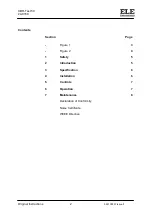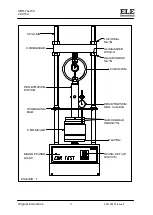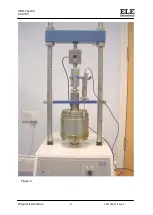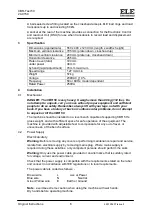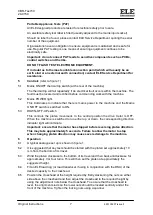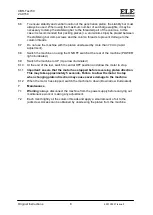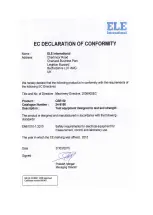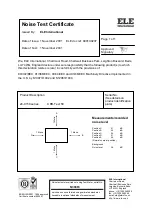
CBR-Test 50
24-9150
Original Instructions
5
9901X0237 Issue 5
1
Safety
This equipment has been tested by ELE International and is safe to use providing that
the proper safety precautions are observed:
Do not use this equipment in any manner, other than as specified in this user
manual; misuse may result in serious injury to personnel.
Do not attempt to operate the equipment with covers removed. Only connect to
the correct electrical supply.
Refer to Installation section before installing machine.
Do not operate machine with wet hands.
Please read this entire manual before unpacking, setting up, or operating this
equipment. Pay particular attention to all
DANGER
and
CAUTION
statements.
Failure to do so could result in serious injury to the operator, or other personnel, or
damage to the equipment. Ensure all moving parts are thoroughly secured before
attempting any maintenance.
1.1
Symbols
Green or Black
P
ROTECTIVE CONDUCTOR TERMINAL
Equipment safety earthing point
Any contrasting
Color
“
I”
=
S
UPPLY
S
WITCHED
“ON”
“O”
=
S
UPPLY
S
WITCHED
“OFF”
Any contrasting
Color
F
USE
,
F
OR SAFE OPERATION OF THE EQUIPMENT
,
USE
ONLY FUSES WITH RATINGS SPECIFIED
Green or Black
Earth (ground)
TERMINAL
Not for safety earthing purposes but provide an earth
reference point.
Background Yellow;
symbol and outline -
Black
Caution, risk of electric shock
Background Yellow;
symbol and outline -
Black
Caution - refer to accompanying documents
Any contrasting
Color
Equipment conforms to the requirements of
European CE Directives, as stated on the
Declaration of Conformity
2
Introduction
This machine has been designed to perform CBR tests which conform to BS 1377
and 1924, ASTM 1883 and to AASHTO T192.
The forces applied are generated by a screw jack via a worm reduction unit driven by
a motor/gear unit. It provides one speed of 1.27 mm/min which satisfies
ASTM/AASHTO Standard and the 1.2 mm ± 0.2 mm/min of the BS Standard. The
worm reduction unit and motor/gear unit is grease packed on assembly and should
not normally require further lubrication.
Rapid adjustment of height of the loading platen is achieved by rotating the platen
anti-clockwise to raise and clockwise to lower.
Limit switches are fitted to prevent over travel on the up and down stroke of the
platen.


